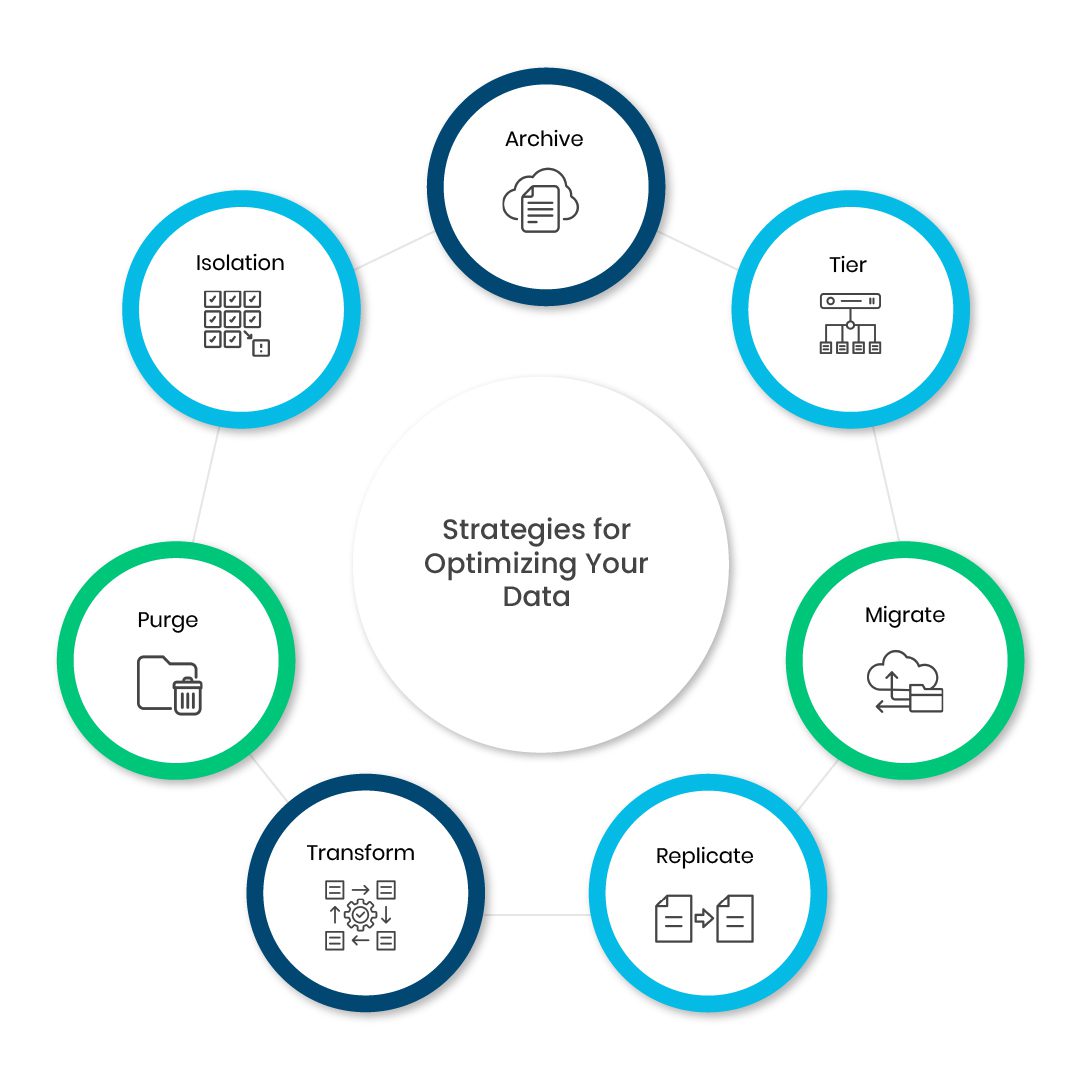- Data is getting generated at the fastest pace in human history. Enterprise customers are growing their data footprint at a rate of 30 to 40 percent year over year. This generates vast amounts of data every day.
- This exponential data growth begs the question: Do enterprises have to store all of it, or do they need to analyze the data before deciding what to do with it?
- Only when the data is secured and stored in the right place can it be used to generate business insights and derive value from it. But this requires the knowledge and the understanding of that data.
- In order to address this challenge, Data Dynamics and Hitachi Vantara have partnered up to help organizations carry out intelligent storage management. The partnership aims to revolutionize enterprise data management, providing comprehensive solutions to facilitate data discovery, prioritizing informed decision-making at every stage of the data lifecycle.
With the advent of smartphones, IoT devices, social media platforms, and digital services permeating nearly every aspect of our lives, the sheer volume of data being produced is staggering. This exponential growth is especially evident among enterprise customers, who are witnessing an unprecedented surge in their data footprints, escalating at a remarkable rate of 30 to 40 percent year over year. This exponential growth presents a crucial dilemma: should organizations store every byte of data, or is it imperative to first analyze its value and then decide its course of action? Navigating this landscape requires a deep understanding of data nuances – its origin, relevance, ownership, importance, sensitivity, and compliance. Recognizing this need, Data Dynamics and Hitachi Vantara have joined forces, offering intelligent storage management solutions to help enterprises unlock the full potential of their data assets. Join us as we delve into the intricacies of intelligent data and storage management, essential elements in driving business innovation and success in today’s data-driven world.
Navigating the Data Deluge
From the moment we wake up to the time we retire for the night, our actions, interactions, and transactions leave behind digital footprints. Whether we’re browsing the web, engaging with social media, making online purchases, streaming content, or even commuting using smart transportation systems, each activity generates a stream of data points. These digital footprints coalesce into vast reservoirs of data, accumulating with each passing moment.
This deluge of data encompasses a myriad of formats, ranging from structured data, such as transaction records and customer profiles, to unstructured data, like social media posts, sensor readings, and multimedia content. According to Forbes, 80% of data generated is unstructured, and most companies only analyze 12% of it. As technology advances and penetrates our daily routines, the volume, velocity, and variety of data being generated show no signs of slowing down. Harnessing this data deluge presents both opportunities and challenges for organizations seeking to derive actionable insights, drive innovation, and stay competitive in an increasingly data-driven world.
This exponential growth of data begs a crucial question for organizations: do they need to store all of it, or is it imperative to analyze the data before determining its significance and potential utility?
The exponential growth of data presents a formidable challenge in terms of storage capacity, infrastructure costs, and the complexity of managing such vast quantities. Simply storing every byte of data without discrimination can quickly overwhelm systems, leading to skyrocketing expenses and operational inefficiencies. Imagine trying to find a needle in a haystack amidst a mountain of unanalyzed, unstructured data – it’s a daunting task. Moreover, the need to classify and categorize sensitive business and customer data for privacy and compliance adds another layer of complexity.
A significant portion of this challenge revolves around unstructured data, which makes up a whopping 80%, according to Gartner. This type of data resembles a wild jungle, lacking the orderly structure of well-managed databases. Despite its chaotic nature, unstructured data holds a treasure trove of insights crucial for understanding customer behavior, market trends, and operational efficiency. However, managing and analyzing such vast volumes poses significant hurdles, particularly in terms of storage and organization. Its complexity often renders it dormant, hiding its potential for driving innovation, mitigating risks, ensuring compliance, and expanding market share. Real-world examples abound, such as financial institutions facing regulatory penalties due to inadequate management of financial documents.
It’s high time for a paradigm shift, recognizing unstructured data management as the next logical step in the evolution of data and storage management. Enterprises must rethink their approach, prioritizing analysis before storage. Adopting a strategic stance toward data management means focusing on relevant, valuable, and actionable data while archiving or discarding redundant, obsolete, or trivial (ROT) data. The goal isn’t merely accumulation but deriving meaningful insights that fuel business value and innovation. By embracing a data-driven mindset, harnessing advanced analytics, and leveraging emerging technologies, organizations can gain a competitive edge, spur growth, and shape the future of their industries.
At the core of this transformation lies the need to have the right data in the right place with the right context. This requires a multifaceted approach, starting with gaining a comprehensive understanding of the organization’s data landscape: what types of data are collected, where they’re stored, how they’re accessed, and who has permission to manipulate or analyze them. Conducting thorough data inventories enables organizations to make informed decisions regarding data storage, retention, and usage policies, thus gaining visibility into their data assets.
From Discovery to Action: A Four-Pronged Approach to Intelligent Data Management
When it comes to storing data, particularly unstructured data, three pivotal questions arise: What data are we storing, do we need it, where is it headed, and is it safeguarded and compliant? These inquiries stand as linchpins for success, spanning from efficient data management and ethical considerations to cost-effectiveness. To address these queries and harness the full potential of their data, businesses are turning to intelligent storage management solutions one that blends IT and data analytics & management. These solutions ensure streamlined data access, improved data quality, and enhanced visibility into data contents. By enabling advanced analytics capabilities and real-time data processing, enterprises can extract valuable business insights while minimizing the risk of overlooking sensitive information. This proactive approach to data management mitigates potential risks and sets the stage for innovation, agility, and competitive advantage in today’s dynamic business landscape. Here’s how:

Data Discovery: Data discovery forms the foundation of data governance, enabling organizations to gain visibility into their data assets and understand their content and context. Through comprehensive data inventories and metadata management, organizations can identify the types of data they possess, where it resides, and how it’s structured. For example, let’s consider a multinational pharmaceutical company. With vast amounts of data generated from clinical trials, research, and development, it’s crucial for them to effectively categorize and secure their data. By implementing robust data discovery processes, they can ensure compliance with regulations like GDPR and HIPAA, protect intellectual property, and streamline collaboration across departments and with external partners.
Analyzing your Data: Once data has been discovered and categorized, the next step is data analysis, where organizations derive insights and value from their data assets. Data analysis encompasses a wide range of techniques, from basic reporting and visualization to advanced analytics and machine learning. By leveraging the content and context of their data, organizations can uncover patterns, trends, and correlations that drive informed decision-making and business innovation. For instance, let’s consider a retail giant leveraging data analysis to optimize their supply chain. By analyzing sales data, customer demographics, and inventory levels, they can predict demand, reduce stockouts, and improve customer satisfaction. This data-driven approach enables them to stay competitive in a rapidly evolving market.
Taking Action: Armed with insights about the whereabouts, nature, frequency of use, size, and importance of your data, you’re now equipped to make informed decisions on how to proceed.
The range of possibilities here is extensive and contingent upon your specific data and enterprise requirements. For instance, if your analysis uncovered numerous redundant files consuming substantial storage space, the logical step would be to eliminate them entirely. Conversely, if your investigation revealed that certain files are frequently accessed by your employees but are currently housed on outdated, underperforming servers, relocating them to a more robust server infrastructure within your lab may be the prudent course of action.
In most scenarios, taking action on your data involves moving files to a designated destination – hence the importance of defining target types. There are various strategies for optimizing your data:
- Archive: Many industries are transitioning their data to object storage, often in the cloud. Object storage is particularly suited for ageing, infrequently accessed, or “cold” data, providing a cost-effective solution for storage when immediate access isn’t necessary.
- Tier: Given the expense associated with faster, high-powered servers, allocating data thoughtfully is imperative. Less frequently used files can be migrated to lower-powered servers, while regularly accessed files require servers with ample resources for optimal performance.
- Migrate: Data migration becomes necessary when transitioning data from one file-based storage resource to another. This could involve upgrading your lab infrastructure or switching to a different file storage provider for improved performance. Migration involves copying files in their entirety utilizing DFS namespaces to redirect traffic seamlessly.
- Replicate: Replicating important files or objects across multiple locations safeguards against potential disruptions such as power or network outages. This entails copying files to another object store or duplicating objects within the same store, preserving the original data on the source.
- Transform: While thorough data scanning and analysis are beneficial, there are instances where migrating entire applications to object storage without exhaustive analysis is preferable. This approach simplifies the migration process, especially when the focus is on relocating entire application sets.
- Purge: Sometimes, the most appropriate action is to purge old, redundant, or unused data entirely from your storage environment. Identifying and deleting such data frees up valuable space and reduces overall storage costs.
- Quarantine: When dealing with sensitive data, employing encryption, access controls, and data masking techniques becomes imperative to mitigate the risk of data breaches or unauthorized access. These measures ensure that sensitive information remains protected against potential threats throughout its lifecycle. Furthermore, organizations must establish comprehensive data retention policies dictating the duration for which data should be retained based on its value, regulatory mandates, and operational requirements. By defining clear guidelines for data retention, organizations can effectively manage storage resources, minimize compliance risks, and align data management practices with broader business objectives.
In a nutshell, storage today has evolved from mere infrastructure mandates to something that’s intelligent, secure, and compliant. The foundation – DATA. That’s where the term Intelligent Data Storage Management comes from – the imperative for securely housing and managing data assets in alignment with their content and sensitivity. This entails deploying resilient storage solutions capable of accommodating the volume and diversity of data while adhering to regulatory mandates and internal policies.
Data Dynamics and Hitachi Vantara Partnership: Enabling Intelligent Storage Management
Hitachi Vantara and Data Dynamics are joining forces to revolutionize enterprise data management, providing comprehensive solutions to facilitate intelligent storage management. Together, their mission is to empower organizations to fortify, oversee, and ensure accessibility to their invaluable data assets.
In reshaping the data storage landscape, Hitachi Vantara introduces an innovative approach that transcends traditional data retention practices. Their vision extends beyond mere storage, emphasizing intelligent storage management analysis as a precursor to data preservation. Recognizing the critical importance of understanding and contextualizing information, Hitachi Vantara’s solution prioritizes informed decision-making at every stage of the data lifecycle.
Augmenting Hitachi Vantara’s suite of storage solutions, Data Dynamics Unified Data Management Software leverages artificial intelligence (AI) and machine learning (ML) to enhance unstructured data discovery. This approach offers precise insights into data landscapes, empowering stakeholders with actionable intelligence for strategic data usage. The software fosters inclusive participation in data management strategies, conducting meticulous analysis to generate insights crucial for risk assessment, compliance, and security enhancement. It lets you enhance your data maturity by efficiently connecting your data across distributed clouds, across teams, and across your value chains. Make the right data available to the right people at the right time with an optimized data ecosystem that enhances business efficiency, accelerates operational excellence, and bolsters data resiliency and reliability. In short, you realize important outcomes to improve your data governance and regulatory compliance. Ultimately, the goal is to facilitate data democratization, enabling effortless access, comprehension, and extraction of insights from extensive unstructured data repositories.
Through this collaboration, businesses spanning various industries can harness Hitachi Vantara’s comprehensive storage portfolio for effective data management. Concurrently, they can leverage Data Dynamics’ analytics expertise to optimize data utilization and streamline operational processes. The partnership aims to strike a balance in data environments, reducing costs, mitigating risks, and maximizing data value while seamlessly integrating with existing IT infrastructure. Beyond storage optimization, the collaboration addresses critical concerns related to data risk exposure by providing insights into data discovery, cataloging, and classification. In an era driven by data-centric decisions, this partnership serves as a transformative force, converting data challenges into strategic advantages for enterprises through advanced AI and ML analytics capabilities.
As businesses navigate the data-centric landscape, the collaboration between Hitachi Vantara and Data Dynamics emerges as a beacon of innovation, empowering enterprises of all sizes and verticals to navigate complex data management landscapes confidently. By doing so, they not only reduce costs and mitigate risks but also unlock new opportunities for maximizing the true potential of data, marking a significant step forward in the evolution of intelligent and responsive data ecosystems – a stride towards data democratization.
For further information or inquiries, please visit our website or contact us via email at solutions@datdyn.com or call us at (713)-491-4298. You can also schedule a meeting with one of our executives to explore the partnership’s intricacies and discover how it can benefit your enterprise. Set up a meeting by clicking here.






